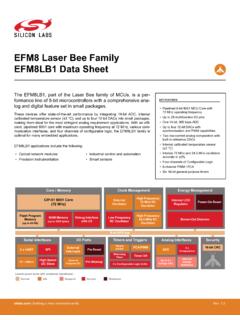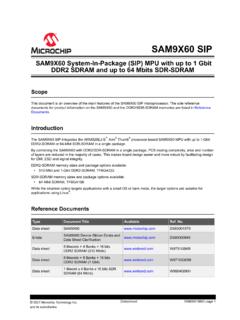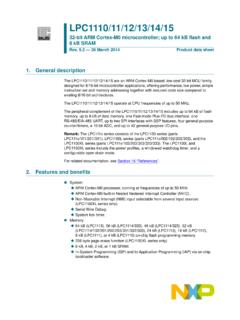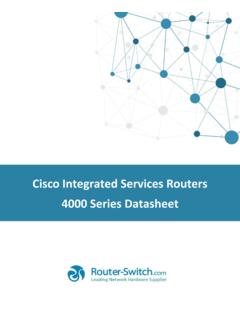Transcription of Bootloader Design for Microcontrollers in Embedded Systems
1 Bootloader Design for MCUs in Embedded Systems June 26, 2015 Rev A2 Embedded Software Design Techniques Page 1 of 20 Bootloader Design for Microcontrollers in Embedded Systems By Jacob Beningo Contact Information: Jacob Beningo Box 400 Linden, Mi 48451 Bootloader Design for MCUs in Embedded Systems June 26, 2015 Rev A2 Embedded Software Design Techniques Page 2 of 20 Jacob Beningo s Background Jacob Beningo, CSDP. Jacob Beningo is a Certified Software Development Professional (CSDP), chair of the IEEE Consultants Affinity Group, an independent consultant and lecturer who specializes in the Design of Embedded software for resource constrained and low energy devices.
2 He has successfully completed projects across a number of industries including automotive, defense, medical and space. He enjoys developing and teaching real-time and software development techniques using the latest methods and tools. He blogs for about Embedded system Design techniques and challenges. He is an avid tweeter, a tip and trick guru, a homebrew connoisseur and a fan of pineapple! Jacob holds Bachelor s degrees in Electrical Engineering, Physics and Mathematics from Central Michigan University and a Master s degree in Space Systems Engineering from the University of Michigan.
3 He can be reached at Other Bootloader Resources Bootloader Design Techniques Workshop (contact for details) Bootloader Design Toolkit (contact for details) Additional resources, templates and Jacob s monthly Embedded software newsletter can be found at . Check out his workshops at Click the social media link below to follow Jacob and get more tips and tricks: Blogs can be found at the following sites by clicking the image: Bootloader Design for MCUs in Embedded Systems June 26, 2015 Rev A2 Embedded Software Design Techniques Page 3 of 20 Table of Contents INTRODUCTION.
4 4 boot -LOADER REQUIREMENTS .. 5 THE boot -LOADER SYSTEM .. 6 boot -LOADER BEHAVIOR .. 7 APPLICATION BEHAVIOR .. 9 START-UP BRANCHING .. 9 MEMORY PARTITIONING .. 12 RESET AND INTERRUPT VECTORS .. 14 APPLICATION FILE FORMAT SELECTION .. 15 Embedded APPLICATION SETUP .. 17 TROUBLESHOOTING .. 17 TROUBLESHOOTING .. 19 REFERENCES .. 19 RECOMMENDED RESOURCES .. 19 APPENDIX A .. 20 Bootloader Design for MCUs in Embedded Systems June 26, 2015 Rev A2 Embedded Software Design Techniques Page 4 of 20 Introduction Microcontrollers have proliferated into every nook and cranny of our daily lives from simple 8-bit devices that control our toaster ovens to powerful 32-bit DSP s that provide us with the rich media and entertainment that we have all become accustomed to.
5 Without Microcontrollers , our lives would not only be less exciting but we would lose a level of control over our world that we can no longer live without. Billions of Microcontrollers are sold each year with the number continually climbing. What happens to these microcontroller based products when millions of units have shipped and a software enhancement needs to be made? Does every unit need to be returned to the manufacturer every time the software is updated? Are televisions, blue-ray players and other devices returned to the manufacturer periodically so that the customer can continue to have the latest and greatest software operating on their device?
6 The obvious answer to these questions is absolutely not and the primary reason why is that most Systems ship with a boot -loader on-board. A boot -loader is an application whose primary purpose is to allow a Systems software to be updated without the use of specialized hardware such as a JTAG programmer. In certain cases, it can also be the earliest point at which the integrity of an Embedded system can be checked. The boot -loader manages the Systems images. There are many different sizes and flavors to Embedded boot - loaders . They can communicate over a variety of protocols such as USART, CAN, I2C, Ethernet, USB and the list goes on for as many protocols that exist.
7 Systems with boot - loaders have at least two program images coexisting on the same micro-controller and must include branch code that performs a check to see if an attempt to update software is in progress. During the initial stages of product development it is very common for the boot -loader to be overlooked by the development team. The primary reason for this is that the boot -loader is not the primary end product that is going to be sold to the customer but the boot -loader is potentially the most important part of that product .
8 The boot -loader allows a company to launch their product with software that only fulfills a portion of their final feature set and then add features to their product once it has been launched into the market. It also allows them to fix bugs that are discovered after the system has been released into the wild. For an Embedded software engineer, a boot -loader requires a full understanding of how a processor works, how to utilize its memory and how to work on the processor at the lowest levels. boot -loader development can be an extremely challenging endeavor to undertake but absolutely a rewarding one.
9 Once a developer has gone through the process, each additional boot -loader becomes easier and easier to implement by following a common and consistent approach to boot -loader Design . The purpose of this paper is to break down the components necessary to develop a boot -loader and present it in an easy to understand methodology that the reader can then use to implement their own boot -loader. While boot - loaders are small programs, they often bring out the worst and nastiest bugs that can be very intimidating to a developer. Not only does the programmer have to dig into flash programming but there is also a need to do a deep dive into memory maps, re-locatable vector tables, copy down functions, flash partitioning, code branching and a number of other tasks which can at first seem monumental and nearly impossible to overcome on a short development schedule.
10 Bootloader Design for MCUs in Embedded Systems June 26, 2015 Rev A2 Embedded Software Design Techniques Page 5 of 20 boot -loader Requirements Before any software project is undertaken, it is always recommended that at a minimum some informal process of requirements gathering be performed. Requirements dictate to the developer what it is that they are going to be designing. Requirements can serve as a roadmap in the Design process. The IEEE Computer Societies Software Body of Knowledge (SWEBOK) defines a software requirement as a property which must be exhibited in order to solve a specific problem (Society, 2004).







